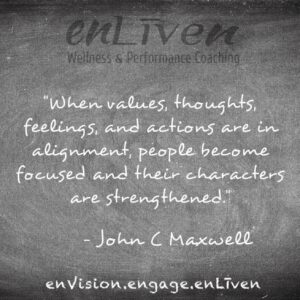
Working with colleagues recently on a personal and professional growth piece on understanding purpose, vision and mission, we had a strong sense that none of that can happen meaningfully if we don’t have a clear understanding of our core values.
Your core values are your most fundamental beliefs and establish the foundation of standards, behaviors and choices. The more closely they are held, the less negotiable they are. Unless you have actually taken the time to identify your core values, you most likely inherited your expression of values from your family, your immediate culture, and those that are closest to you. That said, you probably also notice that sometimes the values that surround you, such as from your parents, just don’t jive with you. Because of that, you may have closely examined a particular value and developed a guiding principle for life. Perhaps it even guides your purpose and mission in life. If you would like to explore your core values, download this tool that I use with my clients.
So What Comes First?
In trying to create a visual representation of the development sequence of purpose, vision, and mission, we seemed to discovered that the process does not seem to be linear, rather a recursive process constantly evolving as we gain new experiences. Though values underlie the process, they too can grow and change because of the process.
The best that I can figure, purpose and vision must evolve before you can determine your mission. To understand that, these terms need definition. At first glance, and in common discussion, the words are often used interchangeably.
Purpose
Your purpose is your reason, your why. Purpose is the driving force that connects your values to your choices. It is the reason you exist (not that there is just one reason).
Vision
Just like eyesight, your vision is what you see when you look ahead. Vision is your future desired state as guided by your values and purpose. But vision isn’t an end state nor is it fixed. If you are open to growth, your vision will continue to evolve as you embark on your mission. You may even set vision markers in the short-term, mid-term, and long-term (you know, that five-year and ten-year plan). Envisioning can be a powerful tool in propelling the mission by creating dissonance in the mind between current state and future state. The mind does not like when things don’t match. It is wired to find patterns and make ideas connect, in psychological terms, known as matrixing. Vision boards are an example of this envisioning. I consider this a vital part of my coaching practice.
Mission
It is where the rubber meets the road, if you will. Mission is how your values and purpose are expressed in action. It is the thread, or staying with the theme, the road that from purpose to vision. Of course, by that description, it seems that linear, something I already suggested it is not. More on that in a bit.
Not everyone starts with a purpose. Sometimes a very clear vision is the impetus. To effectively align day-to-day choices to the vision, understanding values and defining purpose is essential. Without that starting point, it is like trying to navigate out of an unfamiliar forest. Your mission just becomes escaping from the woods, destination unimportant. (Honestly, I think this is how many of us operate when life proceeds unexamined.) From the vision and connected to values, purpose is surmised and defined.
Once the connections are made, as John C Maxwell’s quotes suggests, life becomes sharply focused, delivering a strong sense of meaning. Actions become purposeful, growth becomes the norm, and you become a vital life force, attracting more of who you are becoming.
